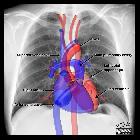heart
The heart is a hollow, muscular organ of the middle mediastinum, designed to pump oxygenated blood around the systemic circulation and de-oxygenated blood around the pulmonary circulation.
Gross anatomy
The heart has a somewhat conical form and is enclosed by the pericardium. It is positioned posteriorly to the body of the sternum with one-third situated on the right and two-thirds on the left of the midline.
The heart measures 12 x 8.5 x 6 cm and weighs ~310 g (males) and ~255 g (females) .
Relations
- anteriorly: the body of the sternum, and adjoining costal cartilages; left lung, and pleura (apex)
- posteriorly: esophagus, descending thoracic aorta, azygos, hemiazygos veins, and thoracic duct
- superiorly: bifurcation of the main pulmonary trunk
- inferiorly: diaphragm
- laterally: lungs, pleura
Chambers
The heart is subdivided by septa into right and left halves, and a constriction subdivides each half of the organ into two cavities, the upper cavity being called the atrium, the lower the ventricle. The heart, therefore, consists of four chambers:
The division of the heart into four cavities is indicated on its surface by grooves. The atria are separated from the ventricles by the coronary sulcus (atrioventricular groove); this contains the trunks of the nutrient vessels of the heart and is deficient in front, where it is crossed by the root of the pulmonary artery. The interatrial groove, separating the two atria, is scarcely marked on the posterior surface while anteriorly it is hidden by the pulmonary trunk and ascending aorta.
The ventricles are separated by two grooves, one of which, the anterior longitudinal sulcus, is situated on the sternocostal surface of the heart, close to its left margin, the other posterior longitudinal sulcus, on the diaphragmatic surface near the right margin; these grooves extend from the base of the ventricular portion to a notch, the incisura apicis cordis, on the acute margin of the heart just to the right of the apex.
Cardiac wall
The cardiac wall or heart wall consists of the following layers from inside to the outside:
Heart valves
The outflow of each chamber is guarded by a heart valve:
- atrioventricular valves between the atria and ventricles
- tricuspid valve
- mitral valve (bicuspid valve)
- semilunar valves which are located in the outflow tracts of the ventricles
It is best to remember the four chambers and four valves in order of the series that blood travels through the heart:
- venous blood returning from the body drains into the right atrium via the SVC, IVC and coronary sinus
- the right atrium pumps blood through the tricuspid valve into the right ventricle
- the right ventricle pumps blood through the pulmonary semilunar valve into the pulmonary trunk to be oxygenated in the lungs
- blood returning from the lungs drains into the left atrium via the four pulmonary veins
- the left atrium pumps blood through the bicuspid (mitral) valve into the left ventricle
- the left ventricle pumps blood through the aortic semilunar valve into the ascending aorta to supply the body
Surfaces
The heart can be described as having the following surfaces:
- posterior surface (base)
- directed upward, backward and to the right
- formed mainly by the left atrium and little by the right atrium
- apex
- directed downward, forward and to the left
- formed by the left ventricle
- anterior (sternocostal) surface
- directed forward, upward and to the left
- formed mainly by the right ventricle inferiorly and superiorly by the atria
- inferior (diaphragmatic) surface
- directed downward, slightly backwards
- formed by the ventricles
- rests mainly upon the central tendon of the diaphragm
- right surface
- long; formed by right atrium superiorly and right ventricle inferiorly
- left (pulmonary) surface
- shorter rounded; formed mainly by the left ventricle and a little superiorly by the left atrium
Borders
The heart has four borders:
- right border: IVC, right atrium, SVC
- left border: left ventricle, left atrium, pulmonary trunk and arch of aorta
- inferior border: right ventricle
- superior border: right and left atria, SVC, ascending aorta and pulmonary trunk
See: Silhouette sign
Arterial supply
Arterial supply is from the coronary arteries with coronary arterial dominance describing the dominant vessel supplying the interventricular septum. The vascular territories of the myocardium are divided into 17 myocardial segments according to the AHA nomenclature.
Venous drainage
Venous drainage is via the variable coronary veins and the coronary sinus.
Innervation
See main article: innervation of the heart.
Lymphatic drainage
Various lymphatic plexuses drain into a right cardiac collecting trunk (draining to anterior mediastinal nodes) and a left cardiac collecting trunk (draining to tracheobronchial nodes and onto paratracheal nodes).
Variant anatomy
The line can become somewhat blurred between what constitutes an anatomical variation and congenital heart disease but the key differentiator could be considered the presence or absence of symptoms in the majority of cases:
- aberrant location of the heart in dextrocardia and situs inversus
- Eustachian valve: remnant valve of the IVC
- Thebesian valve of the coronary sinus
- patent foramen ovale
- coumadin ridge
There is also considerable variation in the anatomy of the coronary circulation and pulmonary veins.
Related pathology
Siehe auch:
und weiter:

 Assoziationen und Differentialdiagnosen zu Herz Anatomie:
Assoziationen und Differentialdiagnosen zu Herz Anatomie:




